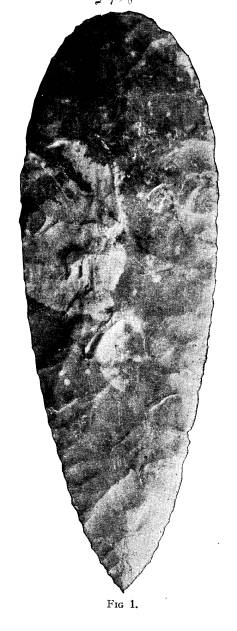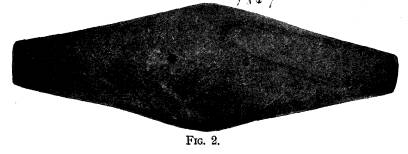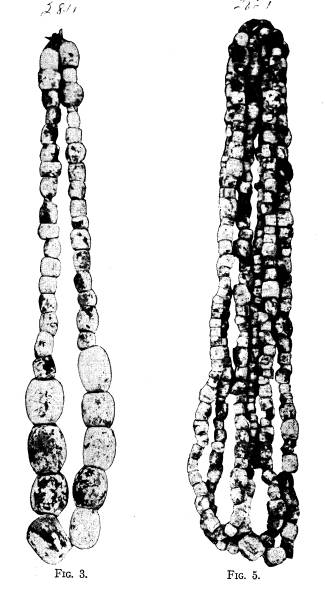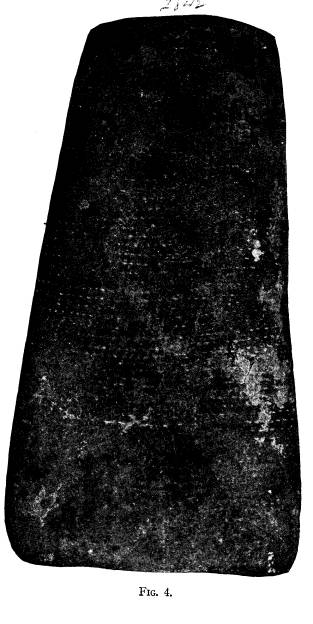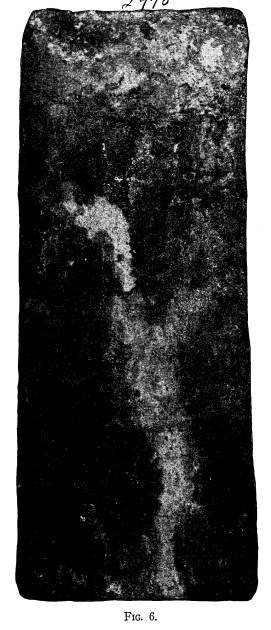Ohio History Journal
- 1
- 2
- 3
- 4
- 5
- 6
- 7
- 8
- 9
- 10
- 11
- 12
- 13
- 14
THE ULRICH GROUP OF
MOUNDS.*
BY TRUMAN B. MILLS.
The Ulrich group of mounds have been so
named by reason
of the location of two of the mounds
upon the farm of Mr.
Joseph Ulrich situated about two and
one-half miles west of
Farmersville, in Jackson township,
Montgomery county, Ohio.
Six or more mounds comprise the group,
four of which were
examined by the writer during the summer
months of 1916 and
1917.
Except for one mound-that located upon the farm
formerly owned by Mr. J. H. Fortney-all
of the mounds were
of very small size. Whether to class
these small tumuli with
the larger one has been a somewhat
puzzling question, but since
they were all explored together, and
found in close proximity
to each other, the term Ulrich Group is
not inappropriate.
All of the mounds examined had been
disturbed, more or
less, by earlier explorers. They left no
written record of their
work, but some of the older inhabitants
of the region stated
that few objects or burials had been
found by these men. At
the Fortney mound, however, it was
evident that three burials
had been disturbed, and some beads, and
objects of copper found.
A diligent search gave us no trace of
the whereabouts of these
specimens, at the present time.
MOUND NO. I.
The first mound of this group to be
examined was located
upon the farm of Mr. Ulrich, two and
one-half miles west of
Farmersville, and three-fourths of a
mile south of the pike.
The mound occupies a position upon the
high ground, in the
* The examination of the Ulrich Group of
Mounds was made by Mr.
Mills under the supervision of the
Curator and the contents of the
group are owned by the museum and now on
exhibition in the North
Hall, second floor. Mr. Mills assisted
in the exploration of the Westen-
haven Mound near Circleville and the
Tremper Mound near Portsmouth
prior to his exploration of the Ulrich
Group.--Editor.
(162)
The Ulrich Group of Mounds. 163
woods, some distance west of Tom's Run,
a tributary to Twin
Creek. The dimensions of the mound were
fifty feet east and
west by forty feet north and south. The
central core of the
mound was removed and only the rim left
standing, but no
traces of graves were found.
Three feet north of the center a charred
log was found,
about two feet above the base-line. Just
over this log was a
cache of leaf-shaped implements, chipped
from vari-colored flint,
and ranging in size from two to three
and one-half inches in
length. There were twenty specimens in
this deposit. Some
of the pieces had been affected by the
heat from the smouldering
log. Two and one-half feet east of this
cache, and at the same
level was another deposit of flint
pieces, similar in design and
workmanship with those of cache number
one. The number of
pieces composing the second find was
twenty-three. Lying just
above this were four spearheads of
larger size. A large spear
five inches in length, of
square-shouldered pattern and made
from a dark colored flint, was found at
a depth of eighteen
inches from the surface of the mound.
Two other flint objects
of the leaf design were found several inches above the last men-
tioned spear. One of these pieces is six
and one-fourth inches
in length, and made from a translucent
piece of chalcedony.
The other is four inches long and two
and one-fourth inches
broad-made from a dark fossiliferous
flint. The most extraor-
dinary specimen in the whole lot,
however, is a cream-colored
leaf-shaped blade made of clear Flint
Ridge chalcedony, ten
inches in length and three inches in
breadth. This large piece
was lying among the roots of a maple
tree, scarcely six inches
below the surface of the mound. The
blade is shown in Fig. 1.
Two weeks digging in the southern and
western portions of
the mound did not bring to light any
more specimens except a
few small flint pieces, and gorget with
concave sides, made of
blue, banded slate. Work was brought to
a close on the mound
without finding any evidence of a burial
having been made by
the builders. Perhaps earlier explorers
took out a skeleton here,
but no record of such has been found to
date.
|
164 Ohio Arch. and Hist. Society Publications. |
|
|
The Ulrich Group of Mounds. 165
MOUND NO. 2.
After finishing mound number one of this
group, work was
begun upon a small mound located north
of number one, on the
same side of the creek, and a few yards
north of the turnpike,
which leads to Farmersville. This work
was about the same
size as number one, and was covered with
a growth of trees of
some size, the roots of which were found
all thru the mound
and, consequently, made digging very
laborious. Aside from this,
the stiff, red clay of the structure was
hard to loosen with the
mattock. The presence of the trees made
it impossible to ex-
amine the entire structure, consequently
we had to be satisfied
with trenching from west to cast.
At a point three and one-half feet
south-west of the center a
large deposit of brick-red clay was
encountered. It appeared
to have been taken up from an area where
a fire had been in
progress for some time. In this mass of
clay were the remains
of a skeleton, the bones of which were
in a broken condition,
and much scattered thru the clay. Some
of the bones showed
signs of having been subjected to heat.
With the skeleton was
a boat-shaped gorget, with two holes
drilled at the center, but
not to completion. A trench dug into the
northern portion of
the mound, a short distance from the
center, revealed a few
pieces of wood, an unfinished slate
object, one large celt, which
had been in the fire, one dark colored,
notched spearhead, three
inches in length, and a boat-shaped
gorget of the same type and
workmanship as the one found with the
skeleton. This last
named gorget was also made of banded
slate, but the two holes
on each side of the center perforated
the gorget. The specimen
is shown in Fig. 2.
Work on the mound was brought to a close
on account of
the extremely hard digging and the
presence of the large trees.
which could not be removed. No doubt a
complete examination
of the mound might reveal more objects
of interest and possibly
another burial.
|
166 Ohio Arch. and Hist. Society Publications. MOUND NO. 3. In the northwestern part of German township, just a few hundred yards from the township line, is situated the third mound of this group. It is also very small; in fact it is the smallest of the three mounds, and is located in the woods on the farm now owned by Mr. Adam Gilbert. Permission to explore the work was obtained from Mr. Gilbert and operations were begun in August, 1916. Previous explorations by others, who had dug into the center, revealed nothing of interest as far as can be learned. The mound measured thirty-nine feet east and west by forty feet north and south. It was built of a stiff clay resembling |
|
|
|
that used in the construction of mound number two. There were no trees growing upon its surface. This, therefore, gave us an opportunity to examine the entire structure. Altho it was the most thoroly explored, it was the least interesting member of the group. Work was begun at the southern rim and carried thru to the north side, taking in this way, the entire structure. At the center, the fragments of a slate tube were found. These pieces had evidently been thrown out by earlier explorers in the course of the work. A thoro examination of the base and the contents of the mound proper revealed nothing until we reached a point a few feet northeast of the center. Here at the base-line the remains of the skeleton of a child were found. The burial had been made in a stiff clay, and consequently nothing remained save a few teeth and the fragments of the skull. Immediately |
The Ulrich Group of Mounds. 167
beneath this, however, at a depth of one
foot below the base-
line, were the remains of an adult
skeleton also very much de-
cayed. In fact, the leg bones were the
only ones that were in a
condition that they could be removed
from the grave. The re-
mainder of the bones were but a mere
semblance of their
former condition. This grave had been
dug below the base, with
the foot of the grave just northeast of
the center of the mound.
Except for a ball made from a granite
rock, which was found
on the base-line just west of the grave,
no relics of any kind
were found here. Following this, the
work was carried to the
northern rim without results.
THE FORTNEY MOUND.
Mound number four of this group is
situated upon the
farm formerly owned by J. H. Fortney,
one and one-fourth
miles southwest of Farmersville, section
thirty-three of Jackson
township. Number four has been called
the "Cedar Mound" or
the "Fortney Mound". Just west
of this large tumulus are
some low earthen walls enclosing a
village site. This place has
been known as "The Fort". It
was perhaps a fortified village
occupied by the builders of the Mound or
by later Indians;
possibly both frequented the site in days
gone by.
The mound was located upon a spur
projecting from the
side of the valley overlooking Twin
Creek. This was an ideal
location for such a monument. From its
crest one could com-
mand a wonderful view of the valley
below. Here the builders
might have come to watch the deer and
other animals as they
came to the creek for water, or to make
observations up and
down the valley for an enemy. The site
is a favorite resort of
visitors even to this day. But the
location is not favorable for its
own preservation. A portion of the work
had already washed
down the hillside, and the remainder was
fast becoming a prey to
the inroads of washouts. In order to
save the contents of this
mound for scientific study it was
necessary to make a complete
examination of the structure.
A survey of the mound found it to be
oblong in shape,
eighty-three feet in length, forty-five
feet in width, and from
twelve to fifteen feet in height on the
crest. The long axis of the
168 Ohio Arch. and Hist.
Society Publications.
work ran somewhat northwest and
southeast. It lay parallel to
the side of the valley. The slopes of
the mound were very
steep and corresponded very well with
the valley wall on the
southern side; this was due, of course,
to erosion.
As the work progressed it became evident
that there were
two different stages in the erection of
the mound. There was,
however, no great lapse of time between
the two stages. These
conclusions are based upon the finding
of the central portion of
the mound composed of a loamy earth
intermingled with a stiff
clay, while the top four or five feet
were found to be composed
of a stiff clay with little or no
"top soil". In many places there
was a strong demarcation between the two
layers, showing that
there was a suspension of the work for a
short time at least.
Perhaps the mound was built to the
height of the central por-
tion and considered completed but the
deaths of some prominent
individuals later prompted the builders
to make additions to the
mound. The truth of this supposition
seems to be borne out
when we note the finding of four graves
in this tough clay sec-
tion of the top and eastern end of the
mound. Now, when this
later addition was made a different kind
of soil was used and it
seems likely that this soil was taken
from the adjacent gullies,
for here would have been an ideal place
for the filling of the
baskets, easily. Why this was not
resorted to in building the
central portion is, of course, a matter
of conjecture.
The examination revealed eight burials,
three of which had
been disturbed by earlier investigators.
These three burials have
been represented as A, B, and C below;
Burial A.-The skeleton found here was
not entire. The
majority of the bones had been removed
by relic hunters years
ago. The grave occupied a position of
prominence at the edge
of the spur, overlooking the valley. It
had been dug to a depth
of about three feet below the base-line,
and the mound was later
erected over it. The persons who dug
here years ago reported
some objects of copper which have been
lost. The grave was
dug beside number five, which will be
spoken of later.
Burial B.-Almost the entire skeleton had
been removed
from this grave prior to our
examination. The grave was located
about ten feet from the southern rim of
the mound, twelve feet
The Ulrich Group of Mounds. 169
east of the center, and two and one-half
feet above the base-line.
A "carpet of bark" had been
prepared in the grave and the body
had been placed upon it. No traces of
relics of any kind were
discovered in the grave.
Burial C.-This grave was found in close
proximity to num-
bers one and two, to be spoken of later.
The burial had been
made near the top of the mound, about
twelve feet east of the
center, and the skeleton had been
exhumed by the Fortney boys,
years before. From them I learned that a
quantity of beads,
similar to the ones found with the other
skeletons in the mound,
had been found by them.
Burial No. 1.-This burial had been made
at a depth of
five feet below the top of the mound,
and twelve feet east of
the center of the structure. The skeleton lay with the head to
the south, and with the body turned upon
its side, a fine layer
of white ashes covered the bottom of the
grave, and extended
for some distance around. Buried with
this individual were two
strands of beads; one strand was placed
around the neck and
the other lay in the abdominal region. The beads found around
the neck are about fifty in number,
rather uniform in size, and
varying in shape from cylindrical to
round. All of them are
made from the columellas of marine
shells. The second strand,
found in the abdominal region numbers
about eighty, and are
all smaller than those found around the
neck. Practically all of
these are of a button shape. Aside from
these objects, a flint
spear, five inches in length made of
dark nodular flint, was
found beside the feet of the skeleton.
Burial No. 2.-Lying just west of number
one about two
feet, and at the same level, was the
skeleton of an old woman,
the bones of which were remarkably well
preserved. All the teeth
had been lost before death except the
lower incisors. The skele-
ton was lying with the head to the
south, a reversed position
from that of skeleton number one. The
bones were lying upon
a layer of ashes, and leaves or twigs,
and some ashes had also
been sprinkled over the body. The only
objects with this skele-
ton were some beads of shell, which, for
the most part were
small, cylindrical, and extremely well
made. The beads were
around the neck. Nine of these occupied
a position just beneath
170 Ohio Arch. and Hist.
Society Publications.
the chin, and were considerably larger than the remaining ones.
These larger beads were well made, about
three-fourths of an
inch in thickness, and cut from the same
material as the first
ones. The necklace is shown in Fig. 3.
Burial No. 3.-This grave lay twenty feet
east of the center,
at a depth of six feet and six inches
below the top of the mound.
The skeleton was lying on a layer of
bark which extended for
two feet on each side of the bones. The
skeleton was that of an
adult female, lying in a horizontal
position with all of the bones
present except those of the feet. It
seems likely that this person
had been interred elsewhere and was
later brought here for
burial. No objects were found in the
grave.
The finding of these four graves,
numbers 1, 2 and 3, to-
gether with C, in the tough clay or
outer mound leads us to
believe that the burials were made here
after work on the inner
mound had been suspended for some time.
The method used in
burying in this section of the mound was
the same as that of the
inner section. The character of the
objects found in the two
sections was the same. In short, no
evidence was found point-
ing to the presence of two different
cultures.
Burial No. 4.-This was the most
interesting of the burials
encountered. We may also call it the
central grave of the
mound. It became evident after the
burial had been worked out
that the skeleton had been placed in
position after the mound
had been built to a height of about
three feet. The death of
this individual who had, perhaps,
superintended the construction
of the mound to that height must have
been a great calamity
for his followers. Therefore, in order
to show respect for their
lost leader, a burial of great pomp was
given him.
A grave of large dimensions was
excavated, from the por-
tion of the mound already built, to a
depth of about three feet,
very near the original surface of the
ground. After finishing
this part of the work a layer of oak
bark and puncheons was
placed in the bottom of the grave, up
the sides, and out for a
short distance upon the level. Then flat
stones (limestones and
shale) were laid around the edges of the
bottom of the grave, and
upon these was placed a double row of
logs, forming, as it were,
a square pen, twelve feet by twelve. In the center of this pre-
|
The Ulrich Group of Mounds. 171 |
|
|
172
Ohio Arch. and Hist. Society
Publications.
pared grave the body was placed, with
feet to the east, and
arms lying naturally by the sides. The
legs and arms showed
traces of the paint which once adorned
the person. Across the
knees was placed a large copper axe,
nine inches long, and five
inches broad at the bit. The edge of the
axe is blunt, showing
that it had not been entirely finished.
Two wrappings of cloth
and buckskin encased the axe, the cloth
having retained its
original shape has left a strong
impression upon the surface of
the axe. The weight of this remarkable
axe is five pounds. The
axe is shown in Fig. 4. Around the neck
of the skeleton was a
strand of beads numbering three hundred.
These beads were
also of shell, finely made and well
polished. They were all
small. The necklace is shown in Fig. 5.
After the interment, a
fine layer of ashes was placed over the
body, and the grave was
then filled with an admixture of fine
woods earths. Following
this the mound was built up to the
second stage.
Burial No. 5.-This was a subterranean
burial placed near
the edge of the spur upon which the
mound was built. The
grave had been dug just west of A, to a
depth of one and one-
half feet. Lying in the grave was the
skeleton of an adult with
some of the bones missing. The
individual, however, was of
some importance as attested by the
character of the objects
placed in the grave with him. Upon the
chest was found a large
rectangular plate of copper, thirteen
inches in length, five inches
in breadth, and thinly beaten. The
surface had been finely
polished, and the piece had, no doubt,
been wrapped in cloth.
A small portion of the cloth still
adheres to the plate. The plate
is shown in Fig. 6. Lying just beneath
this plate was a white
limestone gorget, pierced with two
holes, while scattered about
this were four or five snow-white shell
beads, very poorly pre-
served. No other objects were found.
There was one feature about this last
grave which seemed
to be somewhat unusual. Before the
burial was made here, the
sides of the grave were lined with bark,
and extending from the
head of the grave a carpet of this bark
was laid upon the natural
surface for a distance of six feet
towards the central portion of
the mound. The width of this carpet was
about two and one-half
feet. Just to the left of the bark was a
deposit of charcoal,
|
The Ulrich Group of Mounds. 173 |
|
|
|
174 Ohio Arch. and Hist. Society Publications. |
|
|
The Ulrich Group of Mounds. 175
which seemed to indicate, that a fire
had been in progress here
for some time. Now, the whole
arrangement suggested the idea
that, perhaps, the skeleton had been
brought here from its
original grave and placed upon the
carpet of bark beside this
grave; while it was lying there a fire
was built and some cere-
monies gone thru with before interment
was made. Later the
body was lowered into the grave, the
objects placed with it, and
the earth filled in.
RESUME.
A discussion dealing with the identity
of the builders of
these mounds is not to be entered into
here. A simple record
of facts is given. It is evident,
nevertheless, that the burial
customs of the builders of these mounds
did not differ very
much from those in vogue among the
builders of many other
mounds found in this section of the
state. In conclusion, let it
be sufficient to say, that the mounds
are Pre-Columbian in age.
ACKNOWLEDGMENT.
Many obstacles were encountered in
carrying on this work
and a great deal of the work could not
have been accomplished
without assistance. Accordingly I wish
to acknowledge my in-
debtedness to the following persons:
I am especially indebted to my wife, who
aided me greatly
in the field work, to my father, Dr. D.
C. Mills, for aid and en-
couragement, to Curator W. C. Mills, of
Columbus, for advice
and aid in the field, to Mr. W. P. Lane,
of New Lebanon, for
assistance in the field, and to Mr. H.
C. Shetrone, for prepara-
tion of the photographs for the cuts
shown herewith.
For the many favors shown us in the
field, I am indebted
to the following persons: Mr. Joseph
Ulrich, Mr. Adam Gil-
bert, Mr. Arthur Bauman, Mr. Hugh
Ulrich, and Mr. Walter
Worrel, all of Farmersville, Ohio.
THE ULRICH GROUP OF
MOUNDS.*
BY TRUMAN B. MILLS.
The Ulrich group of mounds have been so
named by reason
of the location of two of the mounds
upon the farm of Mr.
Joseph Ulrich situated about two and
one-half miles west of
Farmersville, in Jackson township,
Montgomery county, Ohio.
Six or more mounds comprise the group,
four of which were
examined by the writer during the summer
months of 1916 and
1917.
Except for one mound-that located upon the farm
formerly owned by Mr. J. H. Fortney-all
of the mounds were
of very small size. Whether to class
these small tumuli with
the larger one has been a somewhat
puzzling question, but since
they were all explored together, and
found in close proximity
to each other, the term Ulrich Group is
not inappropriate.
All of the mounds examined had been
disturbed, more or
less, by earlier explorers. They left no
written record of their
work, but some of the older inhabitants
of the region stated
that few objects or burials had been
found by these men. At
the Fortney mound, however, it was
evident that three burials
had been disturbed, and some beads, and
objects of copper found.
A diligent search gave us no trace of
the whereabouts of these
specimens, at the present time.
MOUND NO. I.
The first mound of this group to be
examined was located
upon the farm of Mr. Ulrich, two and
one-half miles west of
Farmersville, and three-fourths of a
mile south of the pike.
The mound occupies a position upon the
high ground, in the
* The examination of the Ulrich Group of
Mounds was made by Mr.
Mills under the supervision of the
Curator and the contents of the
group are owned by the museum and now on
exhibition in the North
Hall, second floor. Mr. Mills assisted
in the exploration of the Westen-
haven Mound near Circleville and the
Tremper Mound near Portsmouth
prior to his exploration of the Ulrich
Group.--Editor.
(162)
(614) 297-2300
